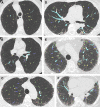Predicting Outcomes in Idiopathic Pulmonary Fibrosis Using Automated Computed Tomographic Analysis
- PMID: 29684284
- PMCID: PMC6222463
- DOI: 10.1164/rccm.201711-2174OC
Predicting Outcomes in Idiopathic Pulmonary Fibrosis Using Automated Computed Tomographic Analysis
Abstract
Rationale: Quantitative computed tomographic (CT) measures of baseline disease severity might identify patients with idiopathic pulmonary fibrosis (IPF) with an increased mortality risk. We evaluated whether quantitative CT variables could act as a cohort enrichment tool in future IPF drug trials.
Objectives: To determine whether computer-derived CT measures, specifically measures of pulmonary vessel-related structures (VRSs), can better predict functional decline and survival in IPF and reduce requisite sample sizes in drug trial populations.
Methods: Patients with IPF undergoing volumetric noncontrast CT imaging at the Royal Brompton Hospital, London, and St. Antonius Hospital, Utrecht, were examined to identify pulmonary function measures (including FVC) and visual and computer-derived (CALIPER [Computer-Aided Lung Informatics for Pathology Evaluation and Rating] software) CT features predictive of mortality and FVC decline. The discovery cohort comprised 247 consecutive patients, with validation of results conducted in a separate cohort of 284 patients, all fulfilling drug trial entry criteria.
Measurements and main results: In the discovery and validation cohorts, CALIPER-derived features, particularly VRS scores, were among the strongest predictors of survival and FVC decline. CALIPER results were accentuated in patients with less extensive disease, outperforming pulmonary function measures. When used as a cohort enrichment tool, a CALIPER VRS score greater than 4.4% of the lung was able to reduce the requisite sample size of an IPF drug trial by 26%.
Conclusions: Our study has validated a new quantitative CT measure in patients with IPF fulfilling drug trial entry criteria-the VRS score-that outperformed current gold standard measures of outcome. When used for cohort enrichment in an IPF drug trial setting, VRS threshold scores can reduce a required IPF drug trial population size by 25%, thereby limiting prohibitive trial costs. Importantly, VRS scores identify patients in whom antifibrotic medication prolongs life and reduces FVC decline.
Keywords: idiopathic pulmonary fibrosis; pulmonary vessels; quantitative computed tomographic imaging.
Figures



Comment in
-
Predicting Outcome in Idiopathic Pulmonary Fibrosis Using Automated Computed Tomography Analysis.Am J Respir Crit Care Med. 2018 Sep 15;198(6):701-702. doi: 10.1164/rccm.201804-0657ED. Am J Respir Crit Care Med. 2018. PMID: 29708398 No abstract available.
References
-
- Navaratnam V, Fleming KM, West J, Smith CJP, Jenkins RG, Fogarty A, et al. The rising incidence of idiopathic pulmonary fibrosis in the U.K. Thorax. 2011;66:462–467. - PubMed
-
- Raghu G, Weycker D, Edelsberg J, Bradford WZ, Oster G. Incidence and prevalence of idiopathic pulmonary fibrosis. Am J Respir Crit Care Med. 2006;174:810–816. - PubMed
-
- Hutchinson J, Fogarty A, Hubbard R, McKeever T. Global incidence and mortality of idiopathic pulmonary fibrosis: a systematic review. Eur Respir J. 2015;46:795–806. - PubMed
Publication types
MeSH terms
Grants and funding
LinkOut - more resources
Full Text Sources
Other Literature Sources
Medical

